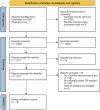Effectiveness of controlled decompression against conventional decompression methods for the management of severe traumatic brain injury patients: a meta-analysis
- PMID: 40102975
- PMCID: PMC11921676
- DOI: 10.1186/s40001-025-02428-3
Effectiveness of controlled decompression against conventional decompression methods for the management of severe traumatic brain injury patients: a meta-analysis
Abstract
Background: Severe traumatic brain injury (TBI) presents significant management challenges, with decompressive surgery being a critical intervention. This review aimed to evaluate the efficacy of controlled decompression versus conventional decompression techniques in managing severe TBI across multiple outcomes.
Methods: A comprehensive search of electronic databases (PubMed Central, SCOPUS, EMBASE, Chinese national knowledge infrastructure, Cochrane trial registry, WHO trials platform) was conducted to identify studies comparing controlled decompression with conventional methods in severe TBI patients. Pooled analysis was done using a random-effects model with inverse variance technique.
Results: Thirteen studies were included. Controlled decompression significantly reduced mortality (OR 0.498, 95% CI 0.321-0.773, p = 0.002), postoperative complications (OR 0.283, 95%CI: 0.205-0.390, p < 0.0001), cerebral infarction (OR 0.488, 95% CI 0.293-0.813, p = 0.006), and brain swelling (OR 0.409, 95% CI 0.252-0.661, p < 0.0001). Improvements were also observed in favorable outcomes (OR 1.822, 95% CI 1.211-2.740, p = 0.004), prognosis (OR 2.488, 95%CI 1.292-4.792, p = 0.006), and total effective rate (OR 6.549, 95% CI 1.852-23.153, p = 0.004). Minimal heterogeneities were found across outcomes, although the quality of evidence was downgraded to low due to higher risk of bias across most studies.
Conclusions: Controlled decompression significantly improves outcomes in severe TBI patients compared to conventional methods. Future high-quality, multicenter randomized controlled trials are recommended to confirm these findings and guide clinical practice.
Keywords: Controlled decompression; Meta-analysis; Traumatic brain injury.
© 2025. The Author(s).
Conflict of interest statement
Declarations. Ethics approval and consent to participate: Not applicable (as this was a systematic review of publicly available manuscripts). Consent for publication: Not applicable. Competing interests: The authors declare no competing interests.
Figures










Similar articles
-
Decompressive craniectomy for the treatment of high intracranial pressure in closed traumatic brain injury.Cochrane Database Syst Rev. 2019 Dec 31;12(12):CD003983. doi: 10.1002/14651858.CD003983.pub3. Cochrane Database Syst Rev. 2019. PMID: 31887790 Free PMC article.
-
Folic acid supplementation and malaria susceptibility and severity among people taking antifolate antimalarial drugs in endemic areas.Cochrane Database Syst Rev. 2022 Feb 1;2(2022):CD014217. doi: 10.1002/14651858.CD014217. Cochrane Database Syst Rev. 2022. PMID: 36321557 Free PMC article.
-
Subacromial decompression surgery for rotator cuff disease.Cochrane Database Syst Rev. 2019 Jan 17;1(1):CD005619. doi: 10.1002/14651858.CD005619.pub3. Cochrane Database Syst Rev. 2019. PMID: 30707445 Free PMC article.
-
Surgery for rotator cuff tears.Cochrane Database Syst Rev. 2019 Dec 9;12(12):CD013502. doi: 10.1002/14651858.CD013502. Cochrane Database Syst Rev. 2019. PMID: 31813166 Free PMC article.
-
Decompressive Craniectomy for Patients with Traumatic Brain Injury: A Pooled Analysis of Randomized Controlled Trials.World Neurosurg. 2020 Jan;133:e135-e148. doi: 10.1016/j.wneu.2019.08.184. Epub 2019 Sep 3. World Neurosurg. 2020. PMID: 31491576
References
-
- Pellot JE, De Jesus O. Cerebral Contusion. In: StatPearls. Treasure Island (FL): StatPearls Publishing. 2024. https://www.ncbi.nlm.nih.gov/books/NBK562147/. Accessed 28 Aug 2023.
-
- Carney N, Totten AM, O’Reilly C, Ullman JS, Hawryluk GW, Bell MJ, Bratton SL, Chesnut R, Harris OA, Kissoon N, Rubiano AM, Shutter L, Tasker RC, Vavilala MS, Wilberger J, Wright DW, Ghajar J. Guidelines for the management of severe traumatic brain injury, fourth edition. Neurosurgery. 2017;80(1):6–15. - PubMed
-
- Hawryluk GWJ, Rubiano AM, Totten AM, O’Reilly C, Ullman JS, Bratton SL, Chesnut R, Harris OA, Kissoon N, Shutter L, Tasker RC, Vavilala MS, Wilberger J, Wright DW, Lumba-Brown A, Ghajar J. Guidelines for the management of severe traumatic brain injury: 2020 update of the decompressive craniectomy recommendations. Neurosurgery. 2020;87(3):427–34. - PMC - PubMed
Publication types
MeSH terms
LinkOut - more resources
Full Text Sources
Medical

